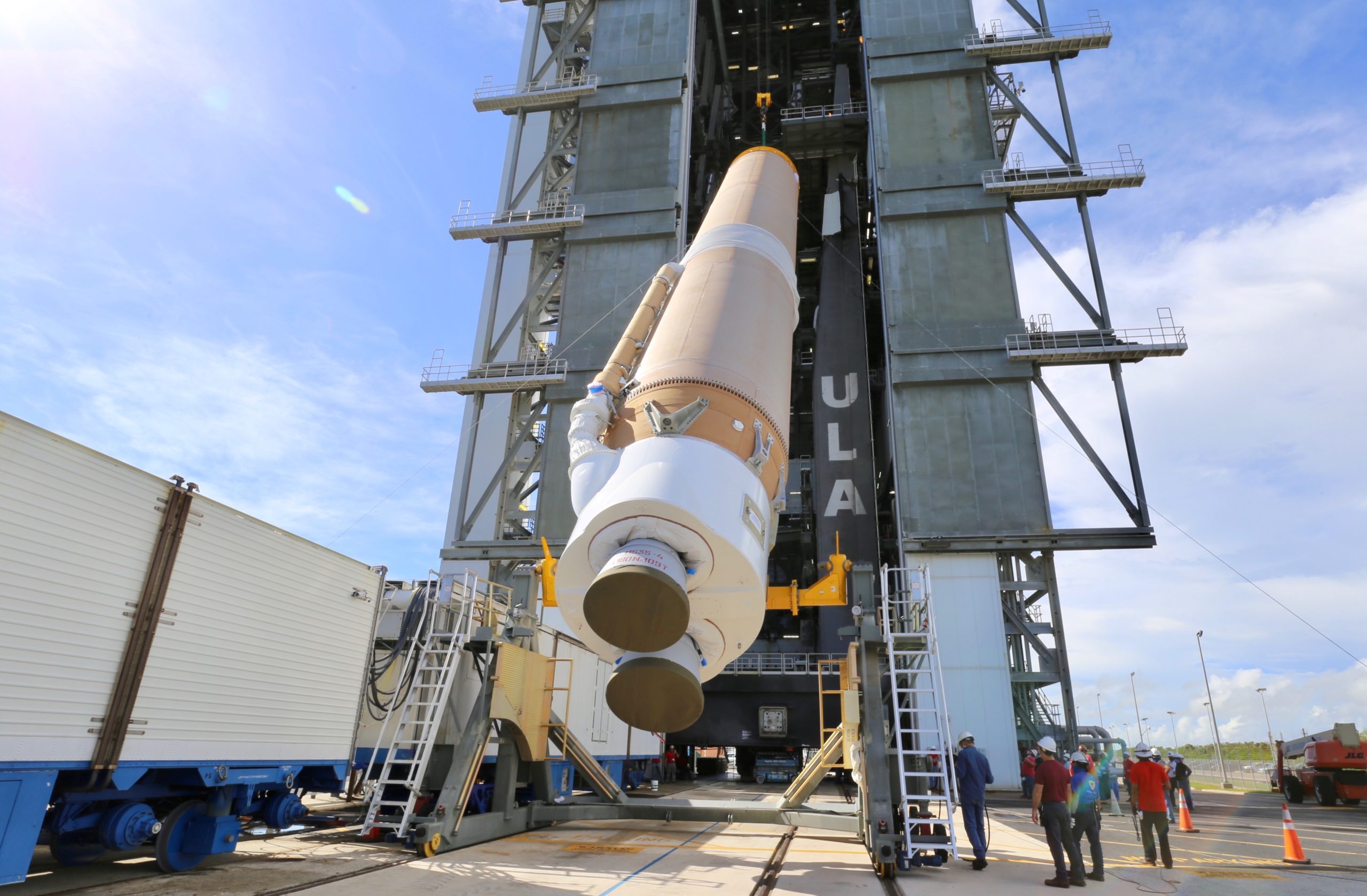
Last flown seven years ago, this week, hardware components for a rarely-used variant of the United Launch Alliance (ULA) Atlas V are coming together in the Vertical Integration Facility (VIF) at Space Launch Complex (SLC)-41 at Cape Canaveral Air Force Station, Fla., ready to deliver a highly secretive payload to orbit on behalf of the National Reconnaissance Office. The Atlas V 531—whose nomenclature identifies a 17-foot-diameter (5-meter) payload fairing, three strap-on, solid-fueled boosters and a single-engine Centaur upper stage—has only flown three times to date but is tasked to launch again later this fall for the classified NROL-101 mission.
Efforts to erect the giant rocket and its new-style, Northrop Grumman Corp.-built solids in the VIF are currently underway in a significant processing milestone known as “Launch Vehicle On Stand” (LVOS).
“Welcome to Cape Canaveral’s Vertical Integration Facility and the start of another #AtlasV launch campaign,” ULA tweeted on 11 September, as the 107-foot-long (32.5-meter) Common Core Booster (CCB) of the Atlas V was hauled horizontally out to the VIF and tilted upright inside its cavernous interior.
Powered by the twin nozzles of a single, Russian-heritage RD-180 engine, capable of 860,000 pounds (390,000 kg) of thrust at T-0, it is the easily recognizable core of a rocket which has so far flown 85 successful missions since August 2002.
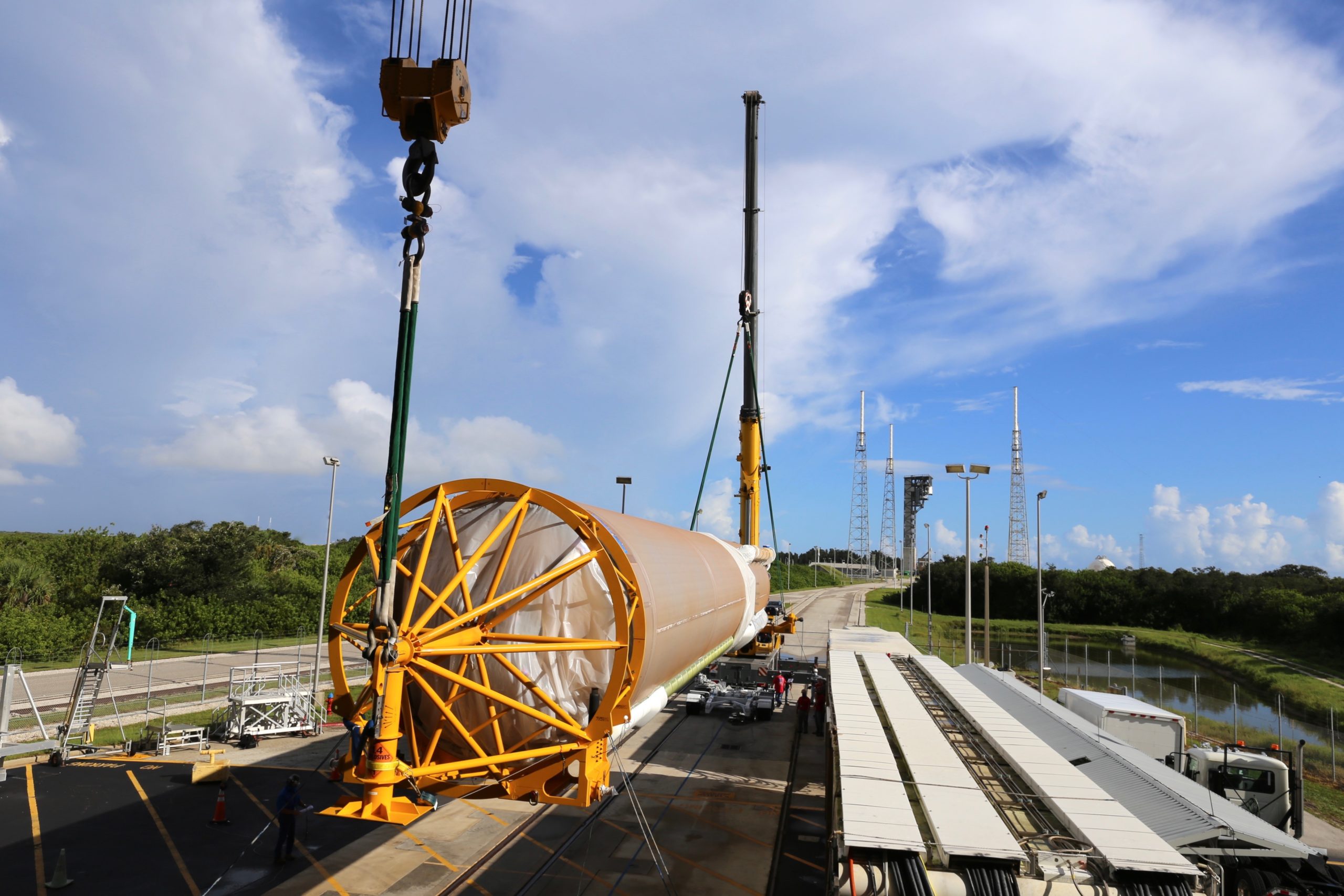
And NROL-101 will mark the fifth Atlas V flight of 2020, coming on the heels of February’s launch of Solar Orbiter, the sixth and final Advanced Extremely High Frequency (AEHF-6) military communications satellite in March, the Space Force’s classified X-37B Orbital Test Vehicle (OTV) mini-shuttle in May and July’s spectacular start of the Perseverance rover on its multi-month voyage to Mars.
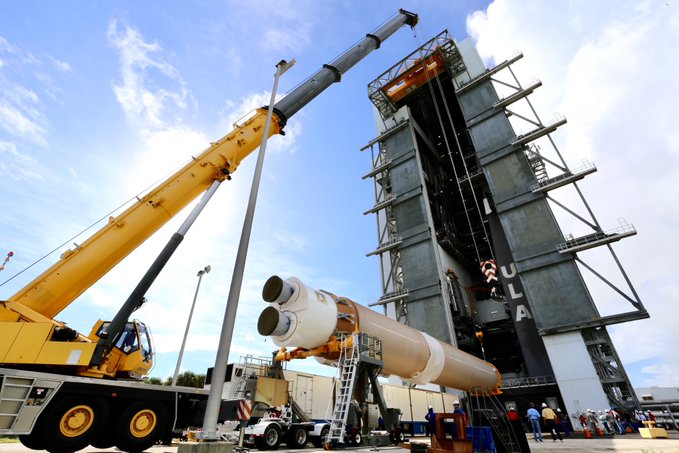
And the AEHF-6 launch is particularly relevant for this next Atlas V launch, for the 531 configuration of the rocket has only flown three missions to date: in August 2010, May 2012 and most recently 18 September 2013, all of which delivered AEHF birds into Geostationary Transfer Orbit (GTO).
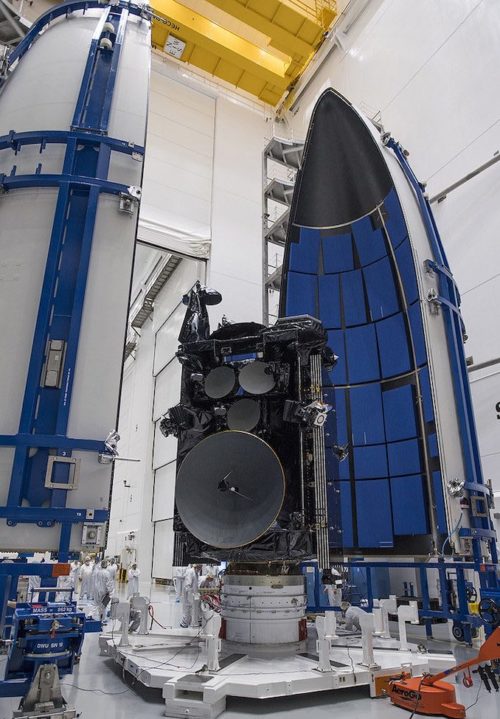
“It’s just a less frequent mass and orbit combination,” ULA CEO Tory Bruno explained in response to a recent question from AmericaSpace. “For perspective, Atlas and Delta together come in over 41 configurations, with most of those being Atlas variants. So small numbers (even zero) for some configurations is to be expected.”
A “middle-of-the-road”-type booster in terms of its overall lifting potential, the 531 can reportedly put 34,350 pounds (15,575 kg) of payload into low-Earth orbit and 16,480 pounds (7,475 kg) to GTO, making it ideally suited to hauling the 13,600-pound (6,170 kg) AEHF payloads aloft. Its use for NROL-101—ULA’s 30th dedicated payload for the NRO—is likely indicative of the satellite’s mass, energy requirement, orbital positioning or potentially all three.
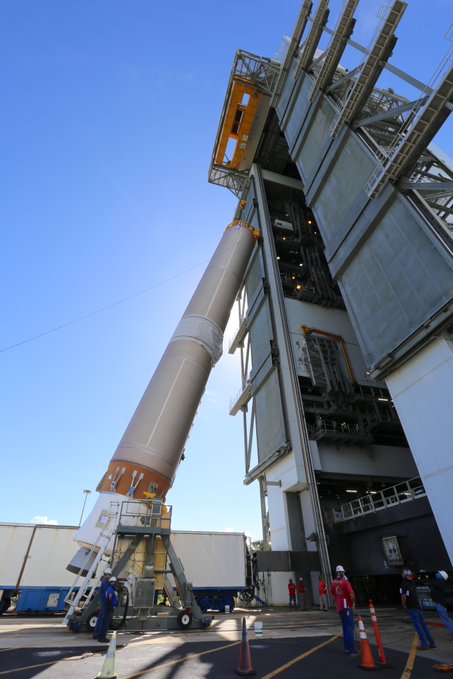
Those 30 NRO missions have been lofted by ULA’s Atlas V and Delta IV product lines. Sixteen Atlas V launches between June 2007 and October 2017 delivered a range of NRO payloads, together with 12 Delta IVs—including six missions by the gargantuan, triple-cored Delta IV Heavy—having flown between June 2006 and January of last year. Another Delta IV Heavy vehicle, currently delayed since 29 August with NROL-44, may fly out of Space Launch Complex (SLC)-37B at the Cape as soon as 18 September.
The exact nature of each mission remains highly classified, although it has been suggested that their purposes and objectives include signals and electronic intelligence gathering, radar and optical imaging and military communications.
The CCB and single-engine Centaur upper stage for the NROL-101 mission arrived on the Space Coast in early July, transported from ULA’s Decatur, Ala., facility via the RocketShip cargo vessel. And after erecting the core stage in the VIF last week, ULA teams are now working to install not only the Centaur, but also a pair of new-style Graphite Epoxy Motors—called GEM-63s—which have been fabricated by Northrop Grumman Corp.
These represent the fourth generation in a long line of GEMs used in conjunction with both Atlas and Delta, whose numerical designation identifies their casing diameter in inches. The 40-inch-diameter (101.6 cm) GEM-40 supported 132 Delta II missions between November 1990 and September 2018, whilst the 46-inch-diameter (116.8 cm) GEM-46 was used in conjunction with the Delta II Heavy for six launches. More recently, the GEM-60 has been partnered with the workhorse Delta IV Medium+ for 26 missions, most recently the booster’s swansong flight in August of last year.
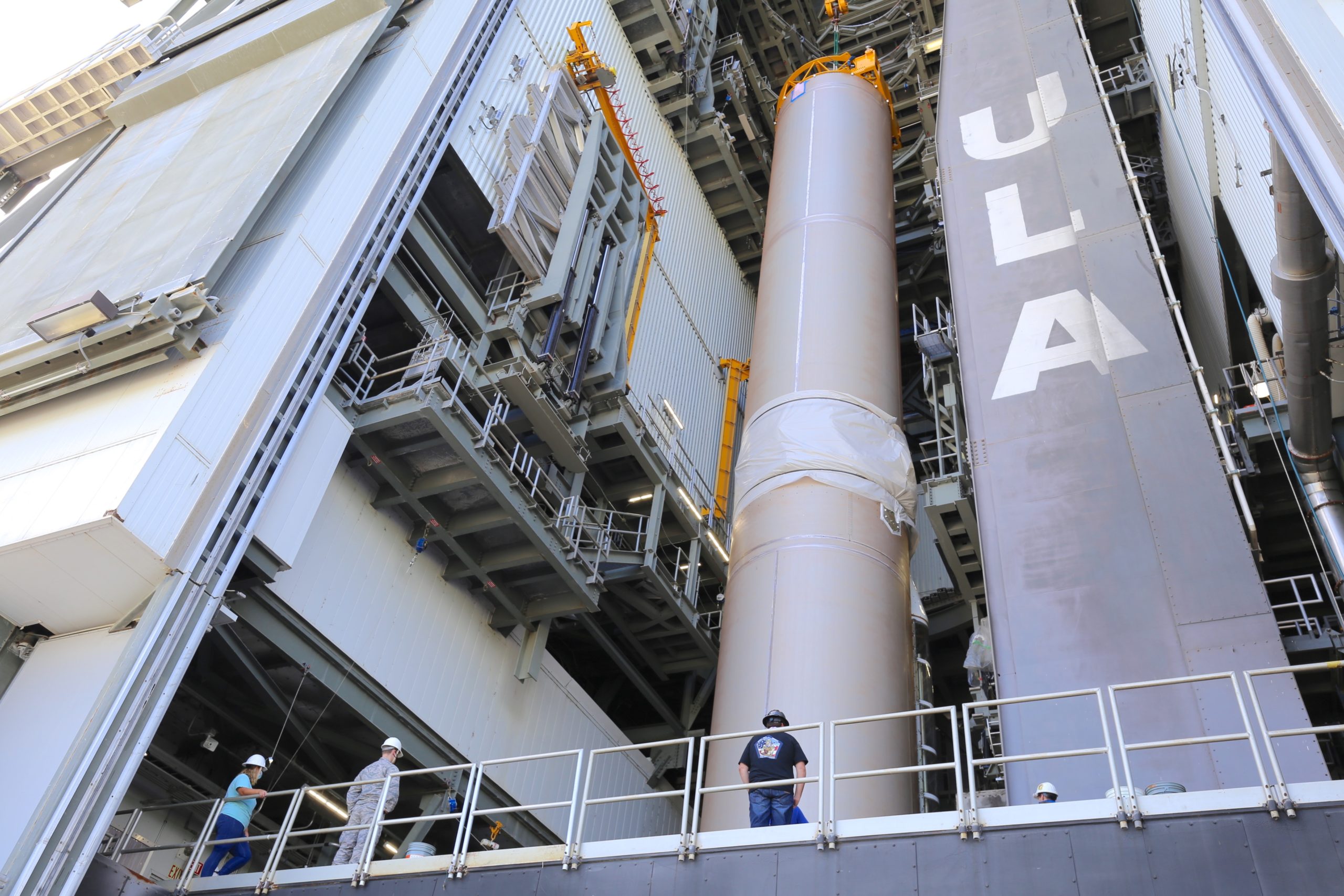
Three GEM-63s are being flown for the first time on the NROL-101 mission. At 63 inches (1.6 meters) in diameter and standing 65 feet (20 meters) tall, they are the longest single-case solid-fueled rocket motor ever developed by Northrop Grumman and will replace both the GEM-60 boosters previously used by the Delta IV and Aerojet Rocketdyne’s AJ-60A boosters previously utilized by the Atlas V.
The origins of the GEM-63 date back to contracts awarded to Orbital ATK back in September 2015, with a key aim to “significantly lower the price to ULA and to the U.S. government”. In tandem with the barebones booster for Atlas V operations, an “extended length” (GEM-63XL) variant was developed for Vulcan, whose 72-foot (22-meter) height makes it the longest single-case solid-fueled rocket motor ever built.
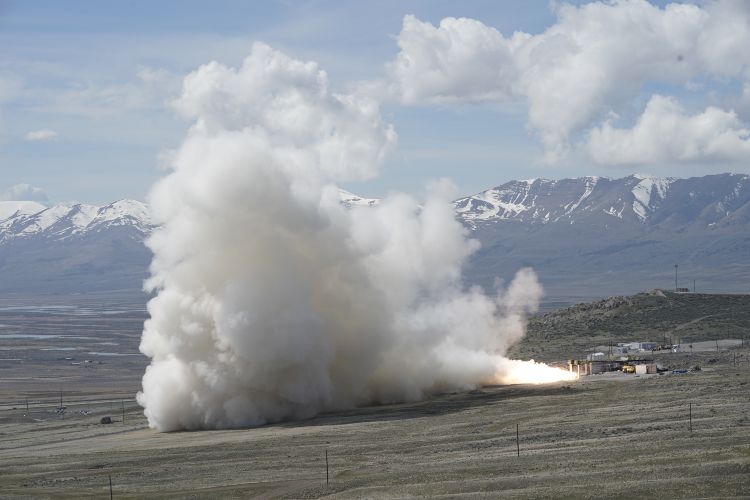
“Since GEM-63 consists of the longest monolithic case manufactured (not necessarily the heaviest), it does pose some challenges such as transporting to the launch site,” Northrop Grumman’s Kendra Kastelan recently told AmericaSpace. “The booster size and weight are pushing the capabilities for over-the-road transport. Special transporters have been fabricated to transport the boosters to Cape Canaveral.”
Within just three years, in September 2018 the GEM-63 completed its first 110-second static fire test at Northrop Grumman’s test area in Promontory, Utah, which qualified it for use on the Atlas V, followed by a second test in early 2019 which qualified it for Air Force missions. A third was completed last October to satisfy Air Force requirements, validate ballistic performance across the temperature range and optimize the nozzle.
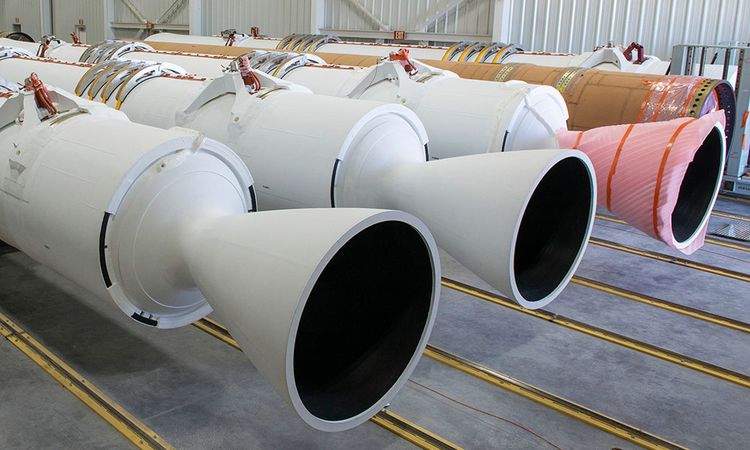
“Designing a drop-in solution for an existing vehicle is no easy feat,” said former shuttle commander Charlie Precourt, now vice president of propulsion systems at Northrop Grumman Corp. “As ULA’s largest legacy supplier, we have been providing rocket propulsion to ULA and its heritage companies since 1964 and we are pleased to continue our partnership with this new generation motor.”
“The GEM-63 utilized many lessons learned from prior GEM programs,” Ms. Kastelan told AmericaSpace. “Some of their design features and manufacturing processes are even common with GEM-63. It is fair to say that GEM-63 wasn’t starting at the beginning of the learning curve, so NGC was able to get to production sooner than a typical program.”
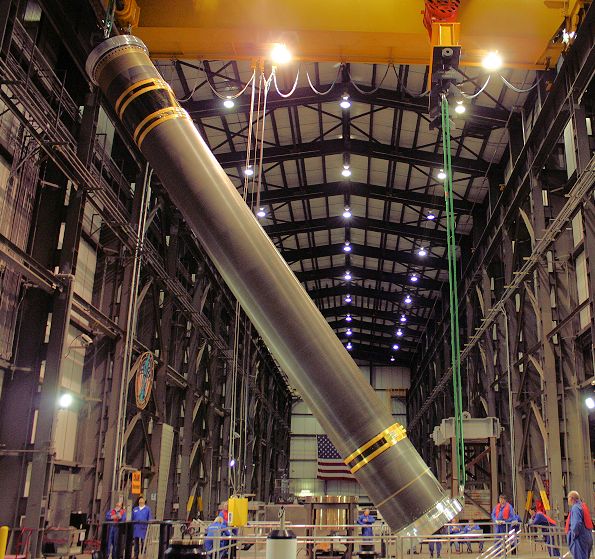
Over-the-Road Transporter (ORT) systems are reportedly employed to move the GEM-63 components, according to Ms. Kastelan. “These ORTs were specifically designed for improving launch site vehicle mating operations and timeline,” she told us earlier in July. “A GEM-63 inert pathfinder was used to demonstrated the booster mating process with the ORT in May 2019.”
Up to five GEM-63s can support a single Atlas V, with three assigned to power the NROL-101 mission away from the pad in September. Each booster generates 373,000 pounds (169,000 kg), which—when combined with the thrust afforded by the Atlas V’s own RD-180 engine—will produce a total thrust at liftoff of close to 2 million pounds (900,000 kg).





